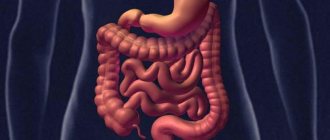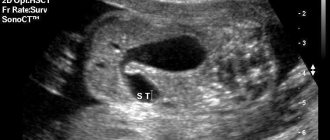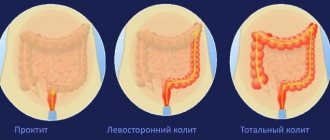Intestinal colic is a common phenomenon characteristic of infants in the first months of life, but it often occurs in older children. This is not a diagnosis, not a disease. This is a symptom, a spasm, a special pain sensation that can accompany various diseases. It is advisable for parents to understand the causes of colic in order to provide their child with timely and competent help or contact a specialist to establish a diagnosis.
Features of intestinal colic in infants
In the third week from birth, the baby may experience painful cramps in the abdomen, to which he reacts with a loud, high-pitched, long cry. The baby's tummy swells and hardens. The child wiggles his legs and becomes restless. Most often, such spasms appear in newborns in the late afternoon (colic time is after 18:00), can last up to 3 hours and end suddenly. The causes of infant colic are not fully understood. It is known that it can be caused by increased gas formation, imperfection of the nerve endings of the newborn’s intestines, due to the certain composition and enzymes of breast milk, which change during the day.
Intestinal colic in such babies is not considered a pathology. The phenomenon disappears without any treatment, on its own, by 3-4 months of life. It is believed that male infants are more likely to suffer from colic.
Only a doctor can reliably determine whether colic in a baby is a symptom of a congenital pathology, and which one. If the child is healthy, then no treatment will be required in this case. Parents will just have to be patient. Over time, the baby's digestive and nervous system improves, and intestinal colic goes away. You can alleviate the baby's condition by laying it on the stomach, lightly massaging the tummy, or applying a warm diaper. A nursing mother's diet or formula should be carefully selected and not provoke increased gas formation, which leads to intestinal colic.
Symptoms
Symptoms of intestinal colic in an infant differ from intestinal spasms in children older than one year. Usually, colic in a baby begins during feeding or immediately after it - after 15 minutes. The child, even if he has managed to fall asleep, wakes up crying, regurgitates food and behaves extremely excitedly. If you touch his tummy at this moment, you will notice how hard and tense it has become.
If a crying baby is offered a breast or a bottle, he will respond with a categorical refusal. The final development of the nervous system and digestive tract of the baby occurs closer to the year, so in the first months of life, intestinal colic in children occurs quite often and has varying severity.
Symptoms of intestinal colic in children under 5 years of age and older are manifested by intense spasms and pain in the intestinal area, bloating, rumbling and upset stools, and the appearance of mucus. During intestinal colic, the child’s condition sharply worsens, general weakness and dizziness are observed.
Since symptoms of intestinal colic in children can accompany various pathologies of the digestive system, it is necessary to find out the cause of the problem and treat it immediately.
Intestinal colic in preschool children
Acute abdominal pain of a spastic nature can also occur in preschoolers, that is, in children older than 1-2 years, disturbing them, causing fear and tears. And if this condition in infants does not cause concern to doctors and colic goes away by 3-4 months, then intestinal pain in children older than one year can be caused by various reasons.
These include:
- Activity of helminths. For example, a ball of roundworms can block the intestinal lumen and cause pain due to obstruction in this place.
- Inflammatory processes in the intestines, gastrointestinal tract.
- Eating disorders, dry food, unhealthy foods.
- Excessive impressionability.
- Congenital pathologies of the digestive organs.
- Appendicular colic.
- Intestinal infection.
- IBS – irritable bowel syndrome.
Colic appears suddenly and is usually followed by loose stools mixed with mucus. If colic is caused by an inflammatory process or infection in the gastrointestinal tract, the child may develop a fever. The pain and burning usually lasts 2-3 minutes, then goes away.
If spasms occur frequently, then it is necessary to examine the child and consult a specialist. After establishing the diagnosis, the doctor will prescribe adequate treatment.
If a strong spasm or colic is caused by increased excitability or excessive impressionability, it is enough to calm the baby, eliminate the cause of the excitement, give him tea with mint, chamomile, valerian, and distract him. And the pain will go away. But it is better to consult a doctor in a timely manner. In case of severe cramps and additional symptoms (vomiting, diarrhea, fever, stomach pain, pain in the side), you must call an ambulance. Before her arrival, no medications, enemas or heating pads should be used to eliminate pain, so as not to blur the clinical picture of the disease and not cause harm.
Causes of intestinal colic
Factors that can trigger the appearance of intestinal colic:
- Regular consumption of fried, smoked, fatty foods in unlimited quantities.
- Eating stale food.
- Lack of any diet - eating on the run, dry food, frequent snacks with sandwiches.
- Various food poisoning - for example, mushroom poisoning, consumption of not fresh fish and meat.
- Sedentary lifestyle, chronic physical inactivity.
- Some infectious intestinal diseases that occur in acute form:
- dysentery is an infectious disease that develops in the large intestine; along with intestinal colic, there is stool with blood or copious mucus;
- acute bacterial infection (salmonellosis) - a pathology that, in addition to the pain syndrome in question, is characterized by high body temperature, vomiting, diarrhea, and headache;
- cholera is an infection that progresses in the small intestine, characterized by uncontrollable diarrhea.
- Acute intestinal inflammation - enterocolitis of various etiologies.
- Impaired movement of feces and food through the intestines - intestinal obstruction.
- Infectious diseases caused by parasites:
- enterobiasis – causes pinworms;
- Giardiasis – caused by Giardia (protozoan microorganisms);
- ascariasis – caused by roundworms;
- opisthorchiasis - caused by the flatworms opisthorchiasis.
In addition, intestinal colic can also be caused by influenza, a viral disease that often “penetrates” the lymph nodes of the abdominal cavity. Under the influence of infection, the nodes begin to enlarge and provoke the pain syndrome in question.
Intestinal colic in school-age children
Intestinal colic in school-age children can also be caused by various diseases, pathologies in the digestive system, infections and helminths.
In addition, it can be provoked by:
- sedentary lifestyle;
- stress caused by increased study load associated with exams, difficult relationships in the team;
- poisoning of the body with heavy metals;
- excessive stress during sports training;
- eating disorders - fast food, irregular meals, energy carbonated drinks.
Frequent, severe, painful abdominal cramps in children aged 7-10 years and older should alert parents and force them to see a doctor. He will conduct a survey about the nature of the pain, when it appeared, and will palpate the indicated location. It will be necessary to take tests of the child’s blood, stool, and urine. Based on the first results of the examination, additional diagnostic measures may be prescribed: ultrasound, tomography, X-ray, colonoscopy, FEGDS. Depending on the data obtained, a diagnosis is established and treatment is prescribed: from medication to surgery.
If intestinal colic was eliminated at home, but recurrences occur, then you cannot risk the child’s health. Without timely consultation with a doctor, you can miss or develop a serious illness - from pancreatitis and appendicitis to a malignant tumor.
In some cases, you can miss time and provoke complications, for example, peritonitis as a result of a ruptured appendix, metastases from a malignant tumor, death of the pancreas - pancreatic necrosis.
What causes colic?
The reasons that cause intestinal spasms in childhood can be very different. Intestinal colic in an infant is a common disorder of intestinal functioning, which is easily explained by the incomplete development of the digestive tract and the immaturity of the nervous system of the newborn. The first symptoms of intestinal colic in infants begin at 3 weeks of life and usually end by 4 months.
In older children, intestinal colic occurs for the following reasons::
- intestinal obstruction;
- helminthiases;
- disruption of the stomach, pancreas and other digestive organs;
- poisoning with salts of heavy metals;
- infectious diseases;
- inflammatory processes in the intestines, for example, colitis;
- stress, psycho-emotional overload;
- excessive exercise, which causes constant irritation of the intestinal loops.
Treatment
Treatment of intestinal colic in newborns is not necessary, since this is not a dangerous condition that occurs in all babies and goes away on its own by 4-6 months of life. Medicines intended to relieve colic in infants do not eliminate spasms in full, slightly reducing the severity of the attack: these are Espumisan, dill water, Disflatil, and the use of a gas tube.
Many experienced pediatricians advise parents to simply survive the period of infant colic by giving the baby a abdominal massage, applying a heating pad, and feeding in an upright position. In exceptional cases, when a child has difficulty withstanding painful spasms, you can try antispasmodics such as Papaverine or No-shpa. The dose of the drug and the course of its administration should be selected by the doctor based on an examination of the baby and the exclusion of other causes that can cause intestinal colic.
Treatment of symptoms of intestinal colic in older children can begin only after the cause of the pathology is known. Usually in these cases, intestinal spasms are a sign of some disease, and in order to cure it, you need to undergo an examination to identify its cause. This is important to consider, since intestinal colic in school-age children may require surgical treatment if it occurs as a result of acute intestinal obstruction, appendicitis, or other causes.
In this case, you need to call an ambulance and do not take any action until the doctor arrives - you cannot offer the child any medications to relieve pain, or apply heating pads, otherwise you can blur the clinical picture of the disease, and the doctor will make an incorrect diagnosis.
If attacks of intestinal colic have occurred not for the first time in a child, and the exact cause of this condition is known, then, as prescribed by the doctor, symptomatic treatment is carried out using drugs that solve the following problems:
- Means for pain relief: No-shpa, Spasmol, Drotaverine, Papaverine, Besalol, Buscopan.
- Medicines to reduce increased gas formation, relieve symptoms of flatulence and bloating: Disflatil, Bobotik, Espumisan.
- Medicines for the relief of diarrhea: Laktofiltrum, Smecta, Enterosgel. Read more about when Smecta is appointed →
How to help a baby with colic
Pain due to intestinal colic can be extremely intense and require immediate correction. First of all, it is necessary to differentiate true colic from diseases. This is especially true for newborn children, since they cannot independently complain and describe the nature of the pain. Treatment tactics and first aid depend on the underlying cause.
First aid
First aid is provided depending on the age of the child.
First of all, it is necessary to determine that the child definitely has colic, and not a serious surgical pathology: appendicitis, intestinal volvulus, peritonitis, and so on. The child needs to measure his or her body temperature, which, if elevated, may indicate the presence of an infectious process. For a child in infancy who is suspected of intestinal colic, it is not recommended to immediately give medications, but to try to get rid of the pathological process using physical methods:
- try to position the child “soldier-style” (vertically) so that excess air comes out of the cavity of the gastrointestinal tube;
- perform a light massage-stroking the abdomen;
- try to breastfeed;
- insert a gas outlet tube into the rectum to improve the passage of gases;
- make a microenema to facilitate emptying.
If after the manipulations regurgitation does not occur, the child does not calm down, then it is necessary to take medicinal measures. If colic occurs frequently, then such a child needs to consult a specialist (pediatrician, pediatric gastroenterologist) to resolve the issue of the main cause of abdominal pain.
Older children can describe the nature of the pain. In this case, it is very important to distinguish colic from acute surgical pathology (appendicitis, peritonitis). As first aid for such children, the most effective is the use of antispasmodics, which help relax the muscles of the gastrointestinal tube and relieve an attack of colic.
Drugs
The main drugs used in infants are:
- "Dill water". The drug can be purchased at pharmacies or made independently. Children are given 10-15 drops, dissolving them in formula or breast milk (see “Using dill water for colic in newborns” for more details).
- Espumisan. 10 drops poured into a feeding bottle at each feeding of the baby or before breastfeeding, after dissolving in water.
- Bobotik. Children of the newborn period (up to 28 days) - 8 drops with each feeding, and infants - 10-15 drops.
Be sure to read:
Short bowel syndrome in a child: treatment and prognosis for life
To relieve pain symptoms, relieve spasms and impaired peristalsis, antispasmodics are recommended:
- Papaverine;
- Spasmalgon;
- No-Shpa.
Nutrition
Nutritional correction is necessary to prevent and prevent the recurrence of colic.
For breastfed children, the diet is necessary for the nursing mother.
| Recommended Products | Not Recommended Products |
|
|
If the child is bottle-fed, it is necessary to check that the formula is diluted correctly according to the instructions.
If everything is done correctly, and the colic does not stop, you need to change the formula. Specially developed fermented milk mixtures are used: Lactodifus, Agu and others. If colic is observed in an older child who is already eating on his own, then it is recommended to stop feeding the baby for a while. An unloaded gastrointestinal tract will allow peristalsis to resume and normalize. Next, the child needs the same diet as nursing mothers to prevent excessive gas formation (see “What foods cause increased gas formation”).
Intestinal colic as a sign of disease
Intestinal spasms in children occur more often or less frequently if they suffer from certain diseases or the body is in a pathological condition.
- Digestive disorders - stomach ulcers, gastritis, liver and pancreas diseases do not allow the tract to fully absorb food. Unprocessed residues enter the intestines and cause spasms.
- Intestinal infections are typical for children under 5–6 years of age. Typhoid fever, salmonellosis, dysentery, cholera and other pathologies affect intestinal motility.
- Helminthiases. Intestinal parasites irritate the nerve endings of the tract and cause intestinal colic. Roundworms twisted into balls clog the gap between the organ sections and cause obstruction.
- Vulnerability of the nervous system. In thin children - suspicious and impressionable, intestinal colic can occur before a public speech, exam or in class if the subject is not fully studied. The condition is familiar to children 7–8 years old and older ones who are prone to anxiety.
Examination for intestinal colic
Diagnosis of the condition in which intestinal spasm occurs is carried out taking into account the doctor’s suspicions of a specific disease. After collecting anamnesis, the child is sent for various studies. A complete blood count reveals anemia and inflammatory changes. The biochemical method shows the ratio of electrolytes and dysfunction of the kidneys, pancreas, and liver.
The coprogram allows you to study the composition of the child’s stool and determine the presence of pathological changes affecting the intestines, pancreas, and liver. Urinalysis also detects disorders of important digestive organs.
To obtain more reliable information, children with intestinal colic are referred for instrumental examination:
- Ultrasound;
- FEGDS;
- colonoscopy;
- sigmoidoscopy;
- CT scan;
- X-ray of the abdominal cavity.
Prevention
The main preventive measures to prevent colic are proper nutrition of the mother and child (see above), compliance with hygiene standards and rules: washing/boiling everything that the child comes into contact with.
If a child has already had an attack of colic, it is recommended to seek help from a pediatrician to identify the underlying cause. With one-time mild colic, you can cope on your own. But if attacks recur regularly, then it is necessary to look for the underlying cause and select corrective therapy.
In continuation of the topic, be sure to read:
- Causes of bloating and increased gas formation, treatment methods
- Irritable bowel syndrome: symptoms and treatments
- What to do if your child is constipated?
- Rectal fissure: causes, symptoms and treatment of pathology
- Causes of abdominal pain: pathological and non-pathological cases
- What medications should I use for increased gas formation?
- Details about the coprogram: preparation, conduct and interpretation of the analysis
- Carminative drugs for adults and children: list of medicines
- Worms in children: how do they manifest themselves and what drugs to treat them with?
- More about hemorrhoids: causes, symptoms and treatment methods
Be sure to read:
Extracellular and intracellular starch in a child’s feces: causes and treatment
Symptoms of intestinal spasms
Clinical symptoms of colic in children appear suddenly with acute sharp pain in the abdomen. Attacks occur after running fast, lifting heavy weights, or eating a heavy meal. Abdominal pain seems cutting to the child. In attempts to get rid of them, the baby changes his body position, becomes capricious, screams, and experiences nervous excitement.
Irritation of the nerve endings of the peritoneum causes symptoms in the child such as flatulence, nausea, problems with bowel movements, and headache. Possible increase in blood pressure. If intestinal colic has had a significant duration, the baby will look tired and indifferent. The diarrhea that appears after the spasm gives sharp relief, but the nagging pain in the abdomen persists.
Dr. Komarovsky draws the attention of parents to the child’s bowel movements. If fatty or mucous inclusions are visible in the feces, this indicates improper digestion of food. The process causes general discomfort, loss of appetite and motor activity.
Intestinal colic as a sign of disease
There are a number of known diseases, the symptom of which is intestinal colic in a child. Firstly, these are diseases of the stomach and pancreas - gastritis and pancreatitis, against the background of which food is not absorbed in full and enters the intestines in an undigested form.
Secondly, intestinal colic can be triggered by irritation of the nerve endings and muscles located on the intestinal walls. This may be due to an intestinal infection, ARVI, or influenza.
Thirdly, intestinal colic, which occurs due to impaired intestinal motility, occurs as a sign of enteritis, irritable bowel syndrome, nervous disorder and other serious diseases that require treatment.
Causes
Non-pathological causes
Physiological causes of colic in childhood include:
- binge eating;
- diet violation;
- early introduction of complementary foods;
- changing milk formula;
- introduction of a new food product.
Intestinal colic that begins in early childhood can provoke or hide intussusception. Intussusception is a life-threatening condition that requires immediate treatment in a surgical department, as it can subsequently transform into necrosis of the invaginated intestinal area.
Pathological causes
There are many more pathological reasons that can cause colic:
- Lactase deficiency - intolerance to milk sugar (lactose) in infancy manifests itself almost from the first month of life.
- Inflammatory diseases of the gastrointestinal tract. Pathological changes in the gastric mucosa and parenchymal organs of the gastrointestinal tract (liver, pancreas) lead to impaired digestion of food and colic.
- Helminthic infestation (worms). Clusters of worms can disrupt the patency of the intestinal tube and cause impaired peristalsis with the formation of intestinal colic.
- Intestinal infections. Infectious lesions lead to severe intoxication, impaired peristalsis, and increased gas formation.
- Stress and nervous overload in older children. Functional digestive disorder, the cause of which is a pathology of nervous regulation against the background of emotional stress.
Be sure to read: Fiber in human nutrition: benefits, content in foods and dietary supplements
Signs of acute intestinal colic
Spastic sensations are always acute and are manifested by a burning sensation in the intestinal area and cramping pain. As soon as the child feels better, he should undergo an examination to clarify the diagnosis that provoked the adverse changes.
The following symptoms will help parents make sure that the spasm is truly acute:
- pain occurs suddenly;
- during cramps, the abdominal muscles tense;
- loose, heterogeneous stool with mucus and a foul odor is released;
- Intestinal spasms in children appear periodically and for a short time.
When intestinal colic occurs, the baby's body temperature may remain normal if the discomfort is not associated with an intestinal infection. When the tract becomes infected, the thermometer reaches high levels, and the symptoms of colic resemble a cold in combination with an intestinal disorder.
What causes colic?
Intestinal colic is provoked by spastic contractions of the small or large intestine, which originate from the small part and spread throughout the entire tract. Usually a spasm occurs due to irritation, which has many causes:
- binge eating;
- helminthic infestations;
- intestinal obstruction;
- poisoning by mushrooms or toxins;
- bacterial damage to the intestines;
- diseases of the oral cavity, stomach, pancreas;
- consumption of stale, low-quality or exotic food;
- stressful situations and nervous overstrain in school-age children adapting to a new way of life.









